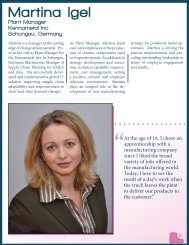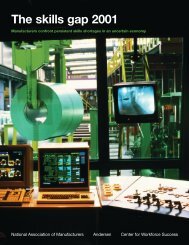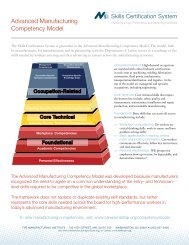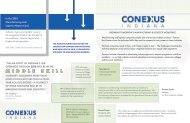2005 Skills Gap Report - Manufacturing Institute
2005 Skills Gap Report - Manufacturing Institute
2005 Skills Gap Report - Manufacturing Institute
You also want an ePaper? Increase the reach of your titles
YUMPU automatically turns print PDFs into web optimized ePapers that Google loves.
<strong>2005</strong> <strong>Skills</strong> <strong>Gap</strong> <strong>Report</strong><br />
Introduction<br />
By Phyllis Eisen, Jerry J. Jasinowski and Richard Kleinert<br />
In spring <strong>2005</strong>, the National Association of<br />
Manufacturers’ <strong>Manufacturing</strong> <strong>Institute</strong>/Center<br />
for Workforce Success and Deloitte Consulting<br />
LLP (Deloitte Consulting) developed the fourth<br />
iteration in a series of surveys designed to learn<br />
more about how manufacturers plan their human<br />
capital strategies and the barriers they<br />
encounter in the process.<br />
The results of this survey confirm the skill<br />
shortages found in earlier reports. However, the<br />
<strong>2005</strong> report goes much beyond earlier findings<br />
in detailing the breadth and depth of the skill<br />
shortage, the negative impact of the shortages on<br />
business operations, and the extraordinary increase<br />
in employee performance requirements.<br />
The picture that emerges is both more complex<br />
and more disturbing than in the past, because<br />
it exposes a broadening gap between the availability<br />
of skilled workers and the employee<br />
performance requirements of modern manufacturing.<br />
Specifically, the research finds:<br />
• Today’s skill shortages are extremely broad<br />
and deep, cutting across industry sectors and<br />
impacting more than 80 percent of companies<br />
surveyed.<br />
• <strong>Skills</strong> shortages are having a widespread<br />
impact on manufacturers’ abilities to achieve<br />
production levels, increase productivity, and<br />
meet customer demands.<br />
• High-performance workforce requirements<br />
have significantly increased as a result of<br />
the skills gap shortage and the challenge of<br />
competing in a global economy, according to<br />
nearly 75 percent of survey respondents.<br />
In sum, the confluence of the above trends and<br />
the increasingly competitive global environment<br />
has created an extraordinary gap between<br />
the supply of skills available and the performance<br />
requirements of the workforce needed<br />
for modern global manufacturing. This human<br />
capital performance gap threatens our<br />
nation’s ability to compete in today’s fastmoving<br />
and increasingly demanding global<br />
economy. It is emerging as our nation’s<br />
most critical business issue.<br />
Clearly, this situation calls for urgent action<br />
by both public and private stakeholders. If<br />
our country is to remain competitive, the issues<br />
of education and training reform now<br />
must be given at least as much focus as top<br />
business concerns of trade, tax, energy, and<br />
regulatory reform. As you read through this<br />
report, we hope to stimulate your thinking and<br />
leave you with an unmistakable sense that your<br />
urgent involvement is needed today.<br />
i







